Japan’s summer is a season that intertwines the harshness of nature with the charm of cultural traditions. For first-time visitors, especially in late July, the country offers an unforgettable experience—a unique blend of breathtaking beauty and intense heat. Understanding how to navigate and embrace this season can transform a challenging visit into an enriching journey.
The Challenge of Japanese Heat and Humidity
Japan in late July is synonymous with “Dai-sho” or “Great Heat,” as outlined in the traditional 24 solar terms, known as sekki. Temperatures frequently soar above 35°C (95°F), with humidity levels often exceeding 80%. This creates a sweltering, almost tropical environment.
In bustling urban centers like Tokyo or Kyoto, the combination of reflective asphalt and crowded streets can make the heat even more overwhelming—a phenomenon known as the “urban heat island effect.” Conversely, in places like Nara, nature provides some respite. The lush greens of Nara Park offer shade, and even the deer can be seen lounging under the trees, seeking refuge from the sun.
The 24 Solar Terms: A Deeper Understanding of Japan’s Seasons
The Japanese calendar divides the year into 24 distinct periods, each intricately tied to natural phenomena. Late July falls into the solar term “Dai-sho,” highlighting the peak of summer. These terms are not merely names but markers of how nature transforms and interacts with human life. They reflect the wisdom of ancient Japan, emphasizing harmony with nature.
Cultural Ways to Beat the Heat
Over centuries, the Japanese have mastered the art of surviving their brutal summers. From traditional customs to modern innovations, here are some examples:
- Seasonal Foods:
- Indulge in kakigōri (shaved ice desserts) or slices of chilled watermelon. These treats are as delicious as they are cooling.
- Try hiyashi chūka, a cold noodle dish served with refreshing toppings like cucumber, ham, and egg.
- Traditional Cooling Tools:
- Carry a sensu (folding fan) to catch a gentle breeze.
- Hang a furin (wind chime), whose delicate sounds evoke a sense of coolness.
- Festival Vibes:
- Attend summer festivals in yukata (light cotton kimono), and savor local snacks while watching fireworks light up the night sky.
Tips for Visitors: Surviving the Summer Heat
To fully enjoy Japan’s summer while staying comfortable and safe, follow these practical suggestions:
- Stay Hydrated: Carry water or a sports drink with you at all times. Vending machines, conveniently found on almost every street corner, offer chilled beverages perfect for the summer heat.
- Plan Your Day Wisely: Avoid midday outings. Instead, explore in the cooler early mornings or evenings, when temperatures are more bearable, and lighting is ideal for photos.
- Dress for Comfort: Wear breathable, lightweight clothing. Hats, sunglasses, and cooling scarves can also help you stay comfortable.
- Escape to Nature: Seek shaded spots like Nara Park, where deer and people alike find solace under the trees. Alternatively, take a trip to the mountains or rivers for cooler air.
Embracing the Challenges: The Beauty of Summer in Japan
Though Japan’s summer may be challenging, its rewards are countless. The vibrant festivals, stunning natural landscapes, and culturally rich experiences make the heat more than worth it. By embracing the practical tips shared here, you can make the most of your journey.
So, whether you’re enjoying a serene sunrise at Nara Park or savoring kakigōri after a long, hot day, you’ll find that Japan’s summer has a unique charm that stays with you long after you leave.



コメント